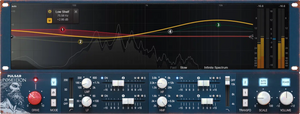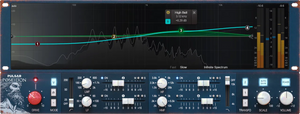Your Cart is Empty


Pulsar Audio Poseidon
A wild EQ modeled after a rare and mythic console, turned into an easy-to-use modern tool
TEST4b
$89.00$49.00Earn [points_amount] when you buy this item.
Description
Ask an engineer for a shortlist of EQs that make their eyes and ears sparkle, and they’ll probably mention an inductor-based design with a nautical name that conjures up images of the god Poseidon. The EQ section of this rare and legendary console made the sound of records you might have grown up with: Queen, The Beatles, David Bowie, The Rolling Stones... Let’s just say it’s “tried and tested”.
Present in very few studios, this console is renowned for being highly musical. One key component behind its mojo are its unique band interactions – pushing the gain of one band can lead to EQ curves that would need three or four bands on a parametric EQ.
With such an idiosyncratic EQ, there’s a learning curve. The interactions between its bands are so unique that we’ve never seen a digital reproduction that makes them simple to use. So we decided to nail it ourselves with an on-screen EQ curve that reacts faithfully to the quirks of the original hardware, making Pulsar Poseidon easy to master.
With all its additional features (Mid/Side bands, Gain Scale, Auto-Gain, multiple saturation colors), this plugin (VST/VST3/AU/AAX) faithfully resurrects the rare and iconic qualities of this console EQ into the digital realm.
EXTENDED RANGES FOR MODERN NEEDS
While the original machine is highly appreciated for its carefully chosen discrete frequencies,
we made the frequency knobs continuous and extended their ranges to match modern needs. Back then, a peaking EQ down to 100Hz would have required fist-sized inductors.
COMPLETE CONTROL WITH CURVE EDITING
Understand how each band or filter shapes the sound with a complete on-screen curve editor and spectrum analyzer. This best-of-both-worlds approach will give you an interesting insight into what you’re doing with a better workflow.
ENHANCED VERSATILITY
As usual, we’ve added Mid/Side processing for more control on your stereo image, a Gain Scale knob to help you reach the sweet spot on your EQ intensity, and an Auto-Gain feature to keep the output level consistent with the input.
SEVERAL SATURATION COLORS
Add rich analog distortion to your sources with multiple saturation circuits, including that of the original unit, which is well-known for the tonal color of its preamps. In addition, we’ve introduced two output transformer emulations to add low-end harmonics.
PRECISE MODELING OF BAND INTERACTIONS
We have faithfully recreated the interaction between the bands of the original unit. The shape of one filter depends on the settings of the others, so you get asymmetrical bells and exotic curves. In Pulsar Poseidon, these creative EQ shapes are finally visible and easy to use.
These consoles have a unique history. They were designed by Malcom Toft, Barry Porter, and among others, producer Roy Thomas Baker (Queen, The Cars, Devo). But more importantly, these consoles emerged at a particular moment in history when mixers and electronic engineers worked hand in hand, in an almost artisanal manner, to create tools exactly suited to their needs. The preamps are entirely Class A and discrete, designed as clones of the Revox A77. Initially, they were supposed to be equipped with Marinair LO10468 input transformers, the same transformers as the mythical Neve 1073 (indeed, all the Neve 10-series).
However, between design and industrialization, Neve had already purchased the entire stock of transformers available from Marinair, so they had to look for an alternative while having to make a few modifications to the circuit in the process. Zutt transformers were finally used. Later, some units were also equipped with Jensen transformers. For a little story, the Lenny Kravitz desk, when in New York City, was upgraded from Zutt to Jensen mic pre-transformers due to the radio interference caused by the NYC train system!
THE MAGIC OF YOUR CHILDHOOD HITS
For the EQs, some simple but smart choices were made to keep the noise floor as low as possible. One cool trick was placing two parallel peaking EQs with minimal decoupling between bands, which helps keep output impedance low. This lovely serendipity made these EQs great because of the musicality of the resulting band interactions. A secret EQ formula that positively contributed to countless hit records, resulting in a rich and dense timbre.
A few bands who recorded on this console include Queen, The Beatles, Metallica, David Bowie, The Rolling Stones, Elton John...
hanks to the Pulsar Audio "savoir-faire," you can now experience and bring back the unique sonic signature behind the records that shaped music history – all with an up-to-date interface and features to integrate and tame this beast inside your DAW.
Tech Specs
Windows
CPU
Intel Core i3 / i5 / i7 / i9 / Xeon or AMD Quad-Core minimum
Memory
4 GB RAM
1 GB free disk space‚Äã
Operating System
Windows 7 with SP1 64 bit
Windows 8.1 64 bit
Windows 10 64 bit‚Äã
GPU
OpengGL 2.0 compatible GPU‚Äã
Monitor
Resolution: minimum 1024x768, recommended 1920x1080
Refresh rate: 60 Hz
Mac OS
CPU
Intel Core i3 / i5 / i7 / Xeon / Apple Silicon (M1)
Memory
4 GB RAM
1 GB free disk space‚Äã
Operating System
MacOS 10.8 - 10.15
GPU
OpengGL 2.0 compatible GPU‚Äã
Monitor
Resolution: minimum 1024x768, recommended 1920x1080
Refresh rate: 60 Hz





